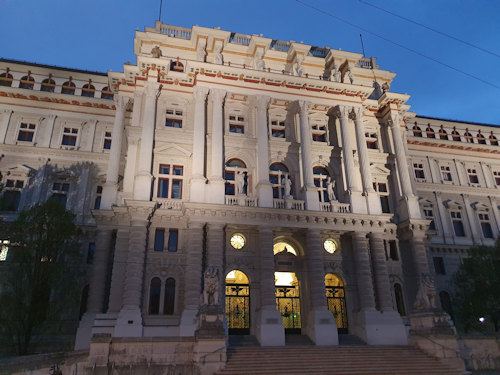
Most visitors to the Justizpalast have business with various courts and legal institutions. But the casual visitor can drop in to enjoy the gorgeous architecture.
- Renaissance-style building completed in 1881
- Go inside and view the arcade court
- Rooftop café open to the public
- You have to go through a security check, of course
- See also:
The Palace of Justice

(The view from Grete-Rehor-Park)
Now there’s a name that sounds like something out of Game of Thrones. The reality is more banal: the Palace of Justice or Justizpalast is home to Austria’s Supreme Court and various other legal institutions.
Such a location hardly makes an obvious candidate for a tourist attraction, but the Justizpalast has three things going for it as a place of interest:
- The remarkable architecture
- Its role in history
- The works canteen (trust me on this)
The building

(Justizpalast shortly after completion; image courtesy of the Rijksmuseum)
The palace joins the long list of late 19th-century constructions that went up when the old city fortifications came down. Architect Alexander Wielemans von Monteforte designed court buildings in other towns and cities, too, including Salzburg.
Emperor Franz Joseph attended the opening on May 22nd, 1881: a dedication stone halfway up the stairs in the atrium commemorates the occasion.
According to one newspaper report of the time, Franz Joseph told the architect that… (my rough translation):
…this magnificent building exceeds all expectations
Another paper, however, described the construction as a grand palace, but claimed a fair few people felt rooms and offices for civil servants might have been constructed at less expense. And… (again, my rough translation):
…the serious workings of justice stand in contrast to the bright and stylish character of their surrounds
(Seems a bit churlish. Employees can work in nice buildings, too. Life doesn’t have to be a George Orwell novel.)

(Inside the Justizpalast around 1899; August Stauda (Photographer); Wien Museum Inv.-Nr. 197175, reproduced with permission under the terms of the CC0 licence)
The Renaissance look of the place reflects the historicism style still valued at the time before the likes of Otto Wagner waved a disparaging finger at such nostalgic approaches.
The richly-decorated interior includes a large flowing staircase in the arcade court that forms the main entrance hall. The steps lead up to a statue of the female personification of justice, her gold sword in hand.
Despite its purpose, the palace remains accessible to the general public. (Though I needed to pass through a security check on my visit, albeit given by the friendliest security officer I’ve ever encountered.)
Once in the main atrium go up one level to view the wonderful ceilings of the surrounding colonnades and side corridors.
Compare today’s building with old photos, though, and you notice slight differences. The changes came about following the ravages of time and war, particularly rebuilding works following a major fire in 1927.
That fire actually represented a significant moment in Austrian politics…
The role in history

(No historical building is complete without a statue of a lion outside)
On July 15th, 1927, a mass protest broke out in Vienna in response to what many saw as the politically-motivated acquittal of what we’d now call far-right extremists. They were accused of killing a child and adult participating in a left-wing march.
The protesters grew increasingly aggressive and a number stormed the Justizpalast, which they saw as a symbol of perceived inequality before the law. Fires broke out, leading to significant damage, particularly since the protests hindered firefighting efforts.
The police response got out of hand (to say the least), with shots fired into the crowd. The death toll eventually reached 89 with hundreds of people injured seriously.
This incident catalysed further polarisation in Austrian society and laid one of the foundation stones for the civil war that eventually broke out in 1934 as the country descended into fascism and headed toward Anschluss with Nazi Germany.
The canteen

(A lucky twilight shot)
On a happier note, today’s Justizpalast attracts more than just government employees and members of the legal profession.
The rooftop canteen – the creatively-named Justiz-Café – doubles up as a café open to the general public. Take the lift to floor 5 to reach it.
A fair few folk find their way there during the week to enjoy the views across the old town, particularly from the open-air terrace.
How to get to the Justizpalast
The Palace of Justice sits just off the famous Ring boulevard, sandwiched roughly between the parliament building and the Museum of Natural History. Since the location is set back behind a small park with trees, people often miss it as they walk around the Ring.
Subway: just a short walk from Volkstheater station on the U3 and U2 lines (the 48A bus and 49 tram also stop here)
Tram: the Auerspergstraße and Schmerlingplatz stops on the 46 tram line sit more or less outside, but you can walk up from a Ring tram stop. For example, the 1, 2, D and 71 lines stop at Ring/Volkstheater.
Address: Schmerlingplatz 11, 1010 Vienna | Website